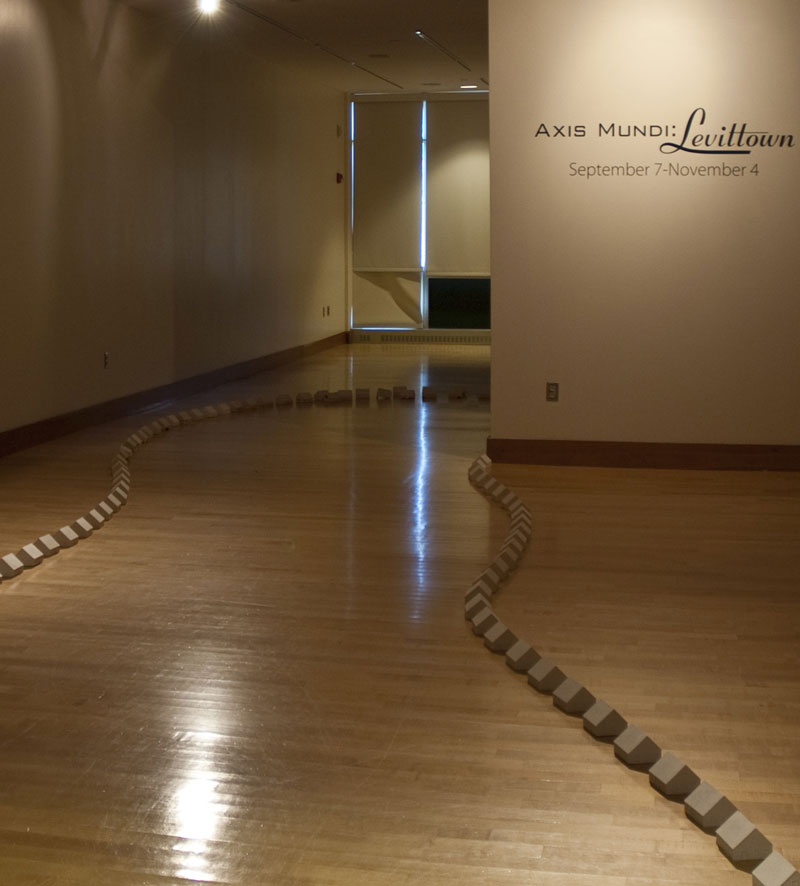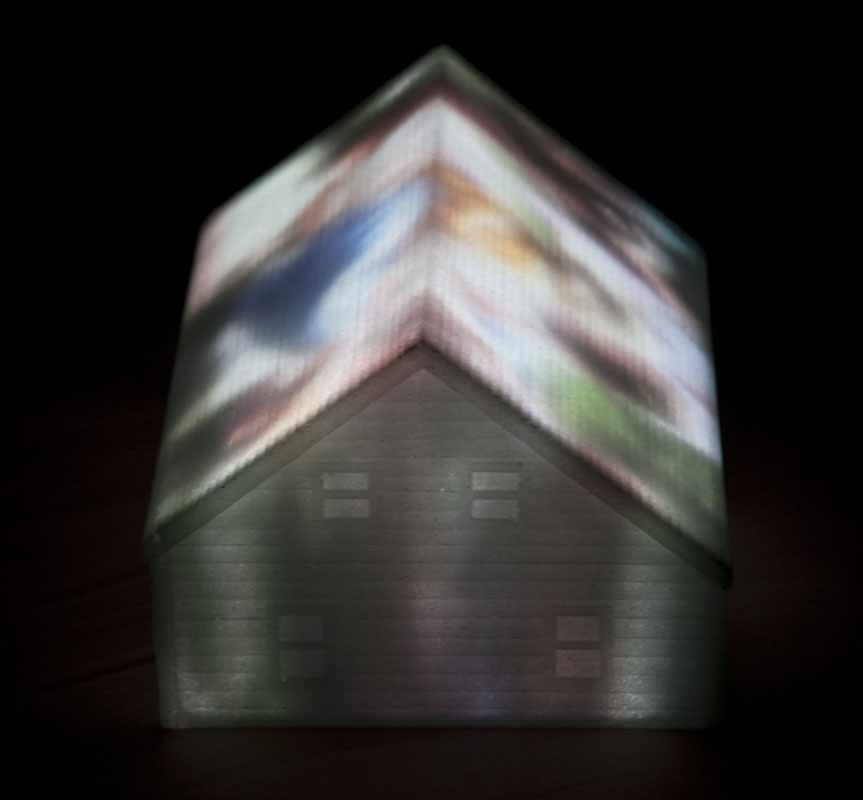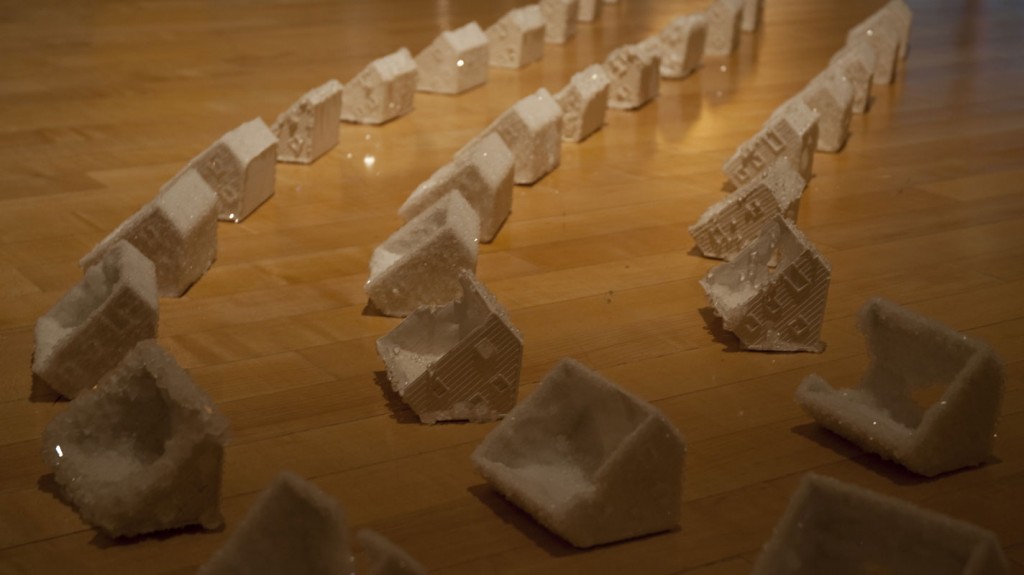Not All That Glitters is Gold
“Axis Mundi: Levittown,” September 7-November 4, 2011
Meredith White-Goode ‘15
Disembodied heads rest on velvet cushions like macabre gifts. Rows of limbless women in black sit in a row, facing the ground. Tiny brasiers and a collection of perfectly detailed legs share the inside of a glass case, like offerings in some sort of dark communion. In these works and others, artist Holly Laws gives life to inanimate objects usually synonymous with death. She formulates stories from sculptures that (sometimes literally) have no face. In her current exhibition project “Axis Mundi: Levittown”—a collaboration with playwright Charlotte Meehan, now on view at Wheaton College’s Beard and Weil Galleries— she tells a story that we do not yet know is our own.
In religion and mythology “Axis Mundi” means the center of the world, the point where heaven and earth connect, an Eden of sorts. For Laws, the American dream of the perfect suburban life was an Eden for many post-war Americans. The original Levittown was built in 1947 by Abraham Levitt and his sons, using the most modern of building methods. Capitalizing on the housing demands of the postwar years, Levittown offered reasonable, mass-produced housing for returning veterans and their families. Levitt, as it seems, was able to see the fears facing most of the country and created a shiny, economically accessible ideal in a world that appeared to be falling apart. Holly Laws used the small, detached, single-family houses of Levittown as the basis for her installation at Wheaton. Through a combination of sound, sculpture, and images, she encourages our rediscovery of hidden things in our own family relationships, while questioning the accepted ideals of family life.
Unlike Laws’ previous work, where the object’s story is often implied, in her current project the tale is much more literal. When you enter the exhibition, tiny clusters of perfectly sculpted houses line your path. The homes, some upended, others lying straight, are encrusted in crystals. The lighting is dim, lending the walls a yellowish glow. You feel calm, almost as if you have entered a glittering, crystal version of the Emerald City. Just as in Oz, however, nothing is quite like it seems. This path leads you inside to the main installation, where you can peek behind the curtain.
As you enter this central gallery beyond the curtain, you receive a baptism of emotional trauma, like the one that comes with being part of a family. The same small, stark, white houses are here treated as canvases, for projected scenes filmed inside real homes. The images are taken from actual home movies. As you see a family sitting down to enjoy a meal, or watch children playing near a staircase, memories of your own childhood may come to mind. The pure white, sparkling beauty of the houses serves as an effective contrast for the implied turmoil that happens inside of them. They are the haunted containers of different families’ broken histories, evoked by pre-recorded conversations that emerge from tiny hidden speakers inside each home. As you listen closely you hear a woman yelling at a neighbor, the sounds of a hand hitting flesh, or a child asking her father why he is so unhappy. The longer you stay, the darker the content becomes. These dialogues are made that much more personal by the fact that they were written by playwright Charlotte Meehan, a former resident of Levittown and a product of the kind of volatile family life captured in the exhibition.
Charlotte Meehan’s powerful dialogues add new life to the houses. But there is also an aura of death suggested by the exhibition, as well as an awakening of the past. The crystallized homes bring to mind the crystallization of fossils, of things old and decayed, yet still beautiful. In some ways we all are looking for our own “Levittown,” a safe place where we can forget about the bad things that have happened to us and find happiness in neat perfection. But, as the exhibition shows, the “death” or removal of one’s self from family, does not mean that the ideals, trauma, or memories disappear with it. Like the voices that emerge from the tiny houses, our memories can resurface at any moment.
While the installation’s goal, according to Laws, was to make visitors “question and address issues of class, gender, race, family relationships [and] our relationship to the American ideal,” it also serves as a reminder that we are forever exiled from Eden. As much as we strive for perfection we will always fall short of it. The exhibition creates a space for you to review your own past and experiences but offers no counsel in how to cope with them. It reveals the thorns on the stems of roses, exposing our reality as what it really is: imperfect. A visually fascinating exhibition, “Axis Mundi: Levittown” is a must-see for anyone interested in thought-provoking multimedia installation.
Meredith White-Goode ’15 is from Brooklyn, New York. She is a student in the FYS, The Art of Writing of Art, and is contemplating a major in art history and minor in women’s studies



-
Categories:
- Art